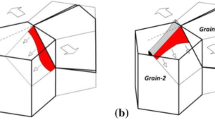Abstract
The influence from different grain boundary configurations on the crack growth rate of a microstructurally short edge crack, located within one grain and subjected to remote fatigue loading, is studied. The study is performed using a dislocation formulation, were the geometry is described by dislocation dipole elements in a boundary element approach and the plasticity by discrete dislocations, located along specific slip planes in the material. Plane strain and quasi-static conditions are assumed. The crack is assumed to grow in a single shear mechanism due to nucleation, glide and annihilation of discrete dislocations. Different grain boundary configurations in front of the growing crack are considered, including both high angle and low angle grain boundaries. It is shown that both grain boundary configuration and distance between the crack and a grain boundary has a pronounced influence on the crack growth rate.
Similar content being viewed by others
References
Askeland DR (1998) The science and engineering of materials, third edition. Stanley Thornes Publishers Ltd, UK
Bjerkén C (2005) The discrete nature of the growth and arrest of microstructurally short fatigue cracks modelled by dislocation technique. Int Jnl Fatigue 27: 21–32
Bjerkén C, Melin S (2004) A study of the influence of grain boundaries on short crack growth during varying load using a dislocation technique. Eng Fract Mech 71(15): 2215–2227
Doquet V (1998) Micromechanical simulations of microstructure-sensitive stage I fatigue crack growth. Fatigue Fract Engng Mater Struct 22: 215–223
Düber O, Künkler B, Krupp U, Christ H-J (2006) Experimental characterization and two-dimensional simulation of short-crack propagation in an austenitic-ferritic duplex steel. Int Jnl Fatigue 28: 983–992
Hansson P, Melin S (2005) Dislocation-based modeling of the growth of a microstructurally short crack by single shear due to fatigue loading. Int Jnl Fatigue 27: 347–356
Hansson P, Melin S (2006) Influence of fatigue load range on the growth of a microstructurally short edge crack simulated by a discrete dislocation formulation. Int Jnl Fatigue 28(7): 714–721
Hansson P, Melin S (2008) Grain boundary influence during short fatigue crack growth using a discrete dislocation technique. Strength Mater 40(1): 150–153
Hansson P, Melin S, Persson C (2008) Computationally efficient modelling of short fatigue crack growth using dislocation formulations. Engng Fract Mech 75: 3189–3205
Hills DA, Kelly PA, Dai DN, Korsunsky AM (1996) Solution of Crack problems: the distributed dislocation technique. Kluwer Academic Publisher, Dordrecht
Hull D, Bacon DJ (2001) Introduction to dislocations, fourth edition. Butterworth-Heinemann, London
Miller GR (1986) The behavior of a crack near a low-angle grain boundary. Int Jnl Fract 31: 143–150
Ohr SM (1985) An electron microscope study of crack tip deformation and its impact on the dislocation theory of fracture. Mat Sci Eng 72: 1–35
Paris PC, Gomez M, Andersson EE (1961) A rational analytic theory of fatigue. Trend Eng 13: 9–14
Pearson S (1975) Initiation of fatigue cracks in commercial aluminium alloys and the subsequent propagation of very short cracks. Engng Fract Mech 7: 235–247
Riemelmoser FO, Pippan R, Kolednik O (1997) Cyclic crack growth in elastic plastic solids: a description in terms of dislocation theory. Comput Mech 20: 139–144
Riemelmoser FO, Gumbsch P, Pippan R (2000) Plastic deformation at short edge cracks under fatigue loading. Eng Fract Mech 66: 357–374
Riemelmoser FO, Gumbsch P, Pippan R (2001) Dislocation modelling of fatigue cracks: an overview. Mater Trans 42((1): 2–13
Shen Z, Wagoner RH, Clark WAT (1988) Dislocation and grain boundary interactions in metals. Acta metall 36(12): 3231–3242
Sugeta A, Uematsu Y, Hashimoto A, Jono M (2004) Atomic force microscopy of fatigue crack growth behaviour in the low K region. Int Jnl Fatigue 26: 1159–1168
Suresh S (1998) Fatigue of materials, second edition. University Press, Cambridge
Zhang JZ (2000) A shear band decohesion model for small fatigue crack growth in an ultra-fine grain aluminium alloy. Eng Fract Mech 65: 665–681
Author information
Authors and Affiliations
Corresponding author
Rights and permissions
About this article
Cite this article
Hansson, P., Melin, S. Grain boundary influence on short fatigue crack growth rate. Int J Fract 165, 199–210 (2010). https://doi.org/10.1007/s10704-010-9512-7
Received:
Accepted:
Published:
Issue Date:
DOI: https://doi.org/10.1007/s10704-010-9512-7



